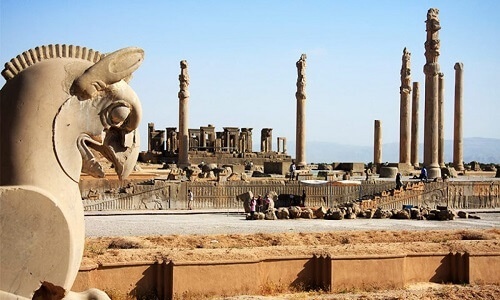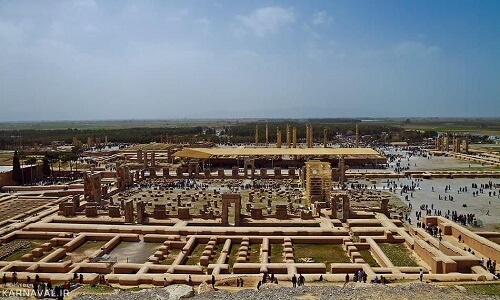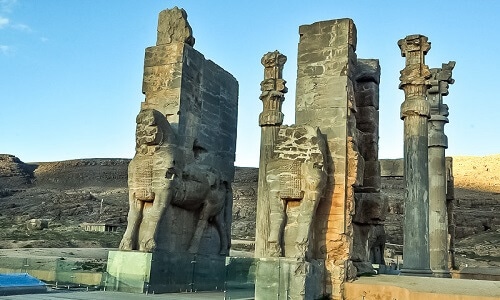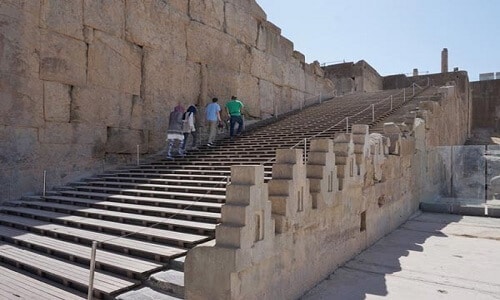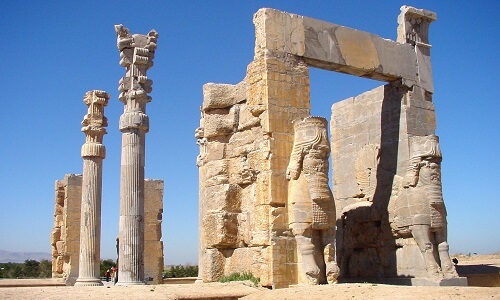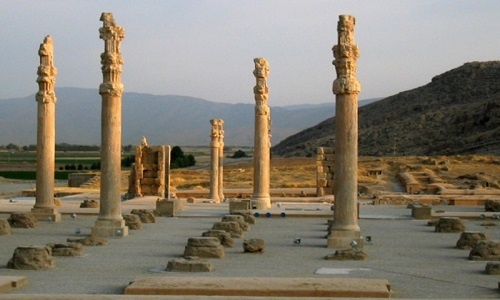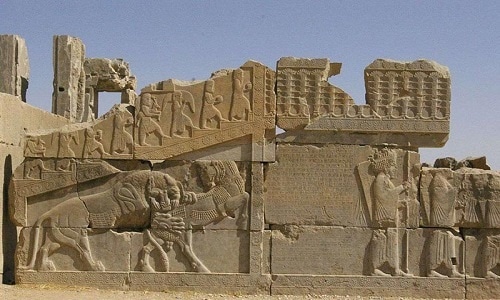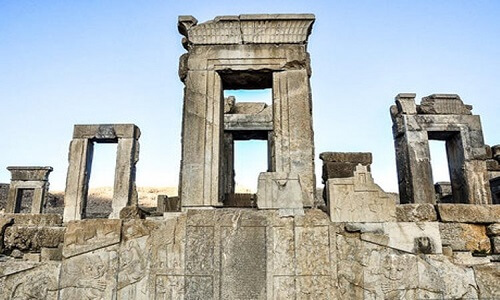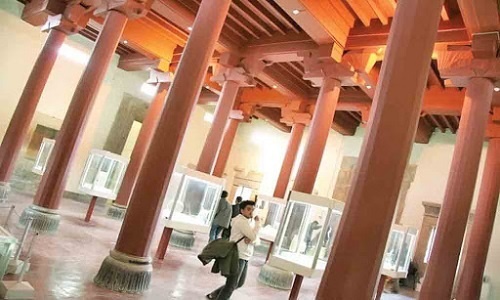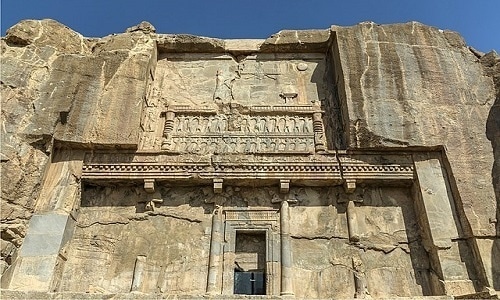Persepolis is one of the most well-known and proudest antiquities in Iran, and everyone is proud of such a magnificent and beautiful complex as a manifestation of Iranian culture in the Achaemenid era. Every year, many domestic and foreign tourists visit the complex, which was inscribed on the UNESCO World Heritage List in 1979.
History of Persepolis
Persepolis, also known as Parseh and Persepolis, is a mirror of the ancient history and culture of Iran, which was built by order of Darius the Great in 518 AH with an area of about 125,000 square meters. In fact, Persepolis is the peak of the elegance and creativity of Iranian artists in applying the culture of different peoples such as Egyptians, Babylonians, Greeks, Medes and Armenians who were under the rule of the Achaemenids. Darius’s purpose in building this complex was to build a capital in his empire that was unparalleled, and for this, he chose the vast plain of Marvdasht which has an ancient historical background.
During the Achaemenid period, there was a residence for each season. The summer residence in Hegmataneh (modern-day Hamedan), the winter residence in Sehush (the capital of Elam) and Persepolis also served as a spring residence for holding Iranian national celebrations (Nowruz). . After Darius the Great, his son Xerxes, as well as his grandson Ardashir I, magnificent buildings were added to the collection. In total, the construction of the palaces of Persepolis took about 180 years, was used for 200 years, and after being destroyed by Alexander the Great, was destroyed and abandoned.
The reason for Persepolis’ naming to “Parseh” was the people of Pars, led by the Achaemenids. They called their residence Persia(Pars), where the Greeks called it Persis, and today we call it Persia(Fars). In the inscriptions that remain from Xerxes on the entrance gate of the Gate of Nations, and also according to some Elamite tablets, the original name of Persepolis is mentioned as “the city of Persia”. It is said that during the Sassanid period, this building was called “One Hundred Columns” and in the Islamic period it was called “Forty Columns”, “Forty Minarets” and “The Throne of Holiness Suleiman”. But later, because people did not know about the creator of this collection, they attributed it to Jamshid, the ancient king, and named it “Persepolis”(throne of Jamshid).
The cause of the burning of Persepolis by Alexander the Great
There are various accounts of the burning of Persepolis. Some believe that Alexander the Great did this in retaliation for the previous defeat of Greece and the humiliation of the Iranians. Others say that Alexander’s mistress, in a drunken state on a banquet held on the occasion of the Greek victory at Persepolis, mistakenly sets fire to a curtain that destroys the ancient monument.
Different parts of Persepolis complex
It will take more than one to two hours to visit all parts of the Persepolis complex. In the following, the information of each section will be provided to you separately.
Entrance stairs
At the entrance of Persepolis, there is a two-sided staircase that was built on the western side of this building at the time of Xerxes. Each side of the staircase has 111 steps, which are considered masterpieces of ancient architecture due to their symmetry.
Gate of All Nations
After passing the entrance stairs, you will reach the magnificent gate of the nations or the gate of Xerxes, which is world famous for its special appearance. In the past, there were four pillars in the middle of this hall, but now three pillars remain. in the west gate, two very large cows, and on the east gate, two huge winged cows with human heads are seen. These creatures represent the legends influenced by the Assyrians and show the greatness of the Achaemenid Empire. Above these gates are inscriptions in ancient Persian, Elamite and Babylonian.
Apadana palace
One of the most beautiful palaces in the Persepolis complex is the Apadana Palace, whose amazing and unique pillars and staircase still stand. The construction of Apadana Palace began during the reign of Darius the Great and was completed after 30 years during the reign of Xerxes.
G palace
In the western part of the G Palace, of which there are not many traces, there are the remains of a tall building which built on a rocky mountain. On the south wall of the building, you can see images of soldiers and crew carrying containers and foodstuffs that have been taken to the south courtyard of Darius’ palace.
Dariush’s private palace
Thatcher’s Palace, or Darius’s Private Palace, is located southwest of Apadana Palace which is one of the first buildings in the Persepolis complex. The word Thatcher or “Taraz” in ancient Persian meant winter home. Pictures of soldiers, Darius with the crew, as well as the battle of the king and the lion can be seen on the gates of Darius’ private palace. Decorations of crowns, bracelets, and precious metals were used in the sculptures of the palace, which were looted by Alexander the Great and his companions.
Central Palace (three gates)
Persepolis Central Palace, which has an area of more than 240,000 square meters, is connected to the adjacent palaces by three gates and several corridors. The construction of this building began in the time of Xerxes and finally at the time of Ardashir III is completed in the center of the hall, there is a stone measuring 75 by 71 centimeters, and in the middle of it, a hole has been dug, which, according to some, was the place to extract the calendar and keep the time, day and month.
H palace
H Palace is actually located in front of Hadish Palace. Its steps, which display two 16-member Persian spearheads as well as ancient Persian inscriptions, are almost destroyed. It is said that the stairs did not belong to this place and were later installed in this space.
Hadish palace
Hadish Palace is located on the east side of Ardeshir Private Palace and on the southeast side of Thatcher Palace. The name Hedish is derived from an inscription on its north porch. Some believe that Hadish was the name of Xerxes’ wife, and for this reason he named this palace” Hadish”. The area of this palace was about 2550 square meters.
Achaemenid Museum
The Achaemenid Museum building is one of the oldest buildings in Iran, which was dedicated to the museum after its reconstruction. The museum is open at certain times of the day and displays some of the artifacts from Persepolis surveys and excavations.
Half-finished gate
The half-finished gate is one of the most valuable buildings in Persepolis and, as its name suggests, it remains half-finished. It was like a gate of nations, except that the two rooms on the east and west fronts, which are supposed to be the place where the guards were stationed. The gate was built in the shape of a winged cow, which was not completed by Alexander the Great.
Flat hall or hundred columns
The Palace of One Hundred Columns is in fact the second largest palace in Persepolis in terms of size, and due to the fact that it has one hundred columns in the Central Hall, it has been called the Hall of One Hundred Columns. The area of this hall is more than 4600 square meters and the height of its columns is about 14 meters. For this reason, it has been dubbed “the world’s largest indoor hall.”
Treasury
The treasury section was built in the southeast of Persepolis and east of the harem. The building was built by order of Darius the Great, and at the reign of Xerxes ended with changes. The treasury is about 10,390 square meters.
Tombs
In addition to several palaces, the tombs of Ardashir II and Ardashir III of the Achaemenids are located on Mount Rahmat and facing the Persepolis complex. The tombs look like a cross with four equal branches. A tomb is located behind a hill south of Persepolis, which is attributed to Darius III.
Cost and time table to visit Persepolis (Parse)
Ticket price: 500,000 Rials
Opening hours: 8:00- 23:00
English and Farsi address of Persepolis (Parse)
Persepolis building, 10 km northeast of Marvdasht, Fars province (the distance from Persepolis to Shiraz is about 60 km.)
استان فارس، 10 کیلومتری شمال شرق مرودشت، بنای تخت جمشید (فاصله تخت جمشید تا شیراز حدود 60 کیلومتر است.)
This post is also available in:  中文 (Chinese)
中文 (Chinese)






